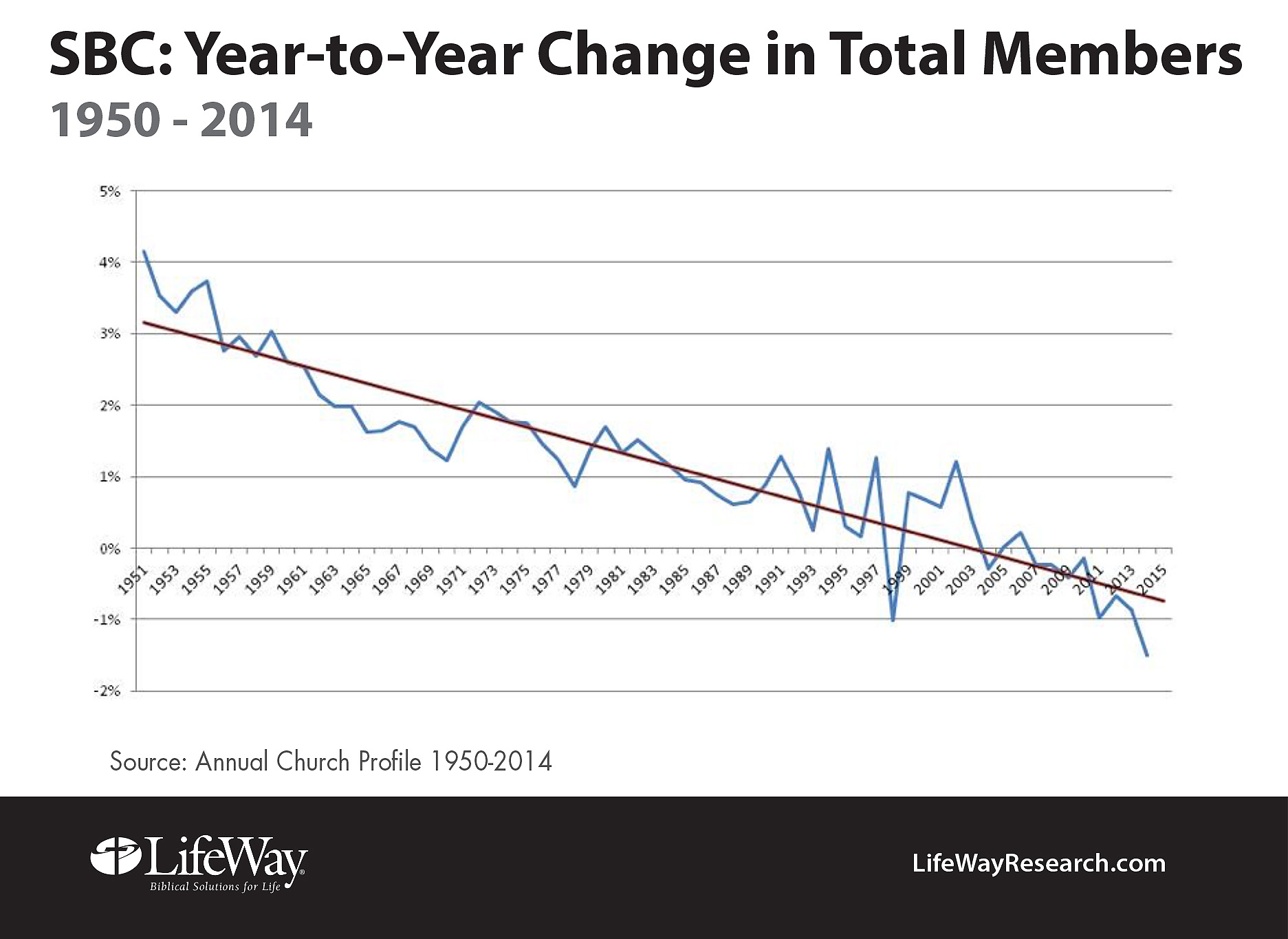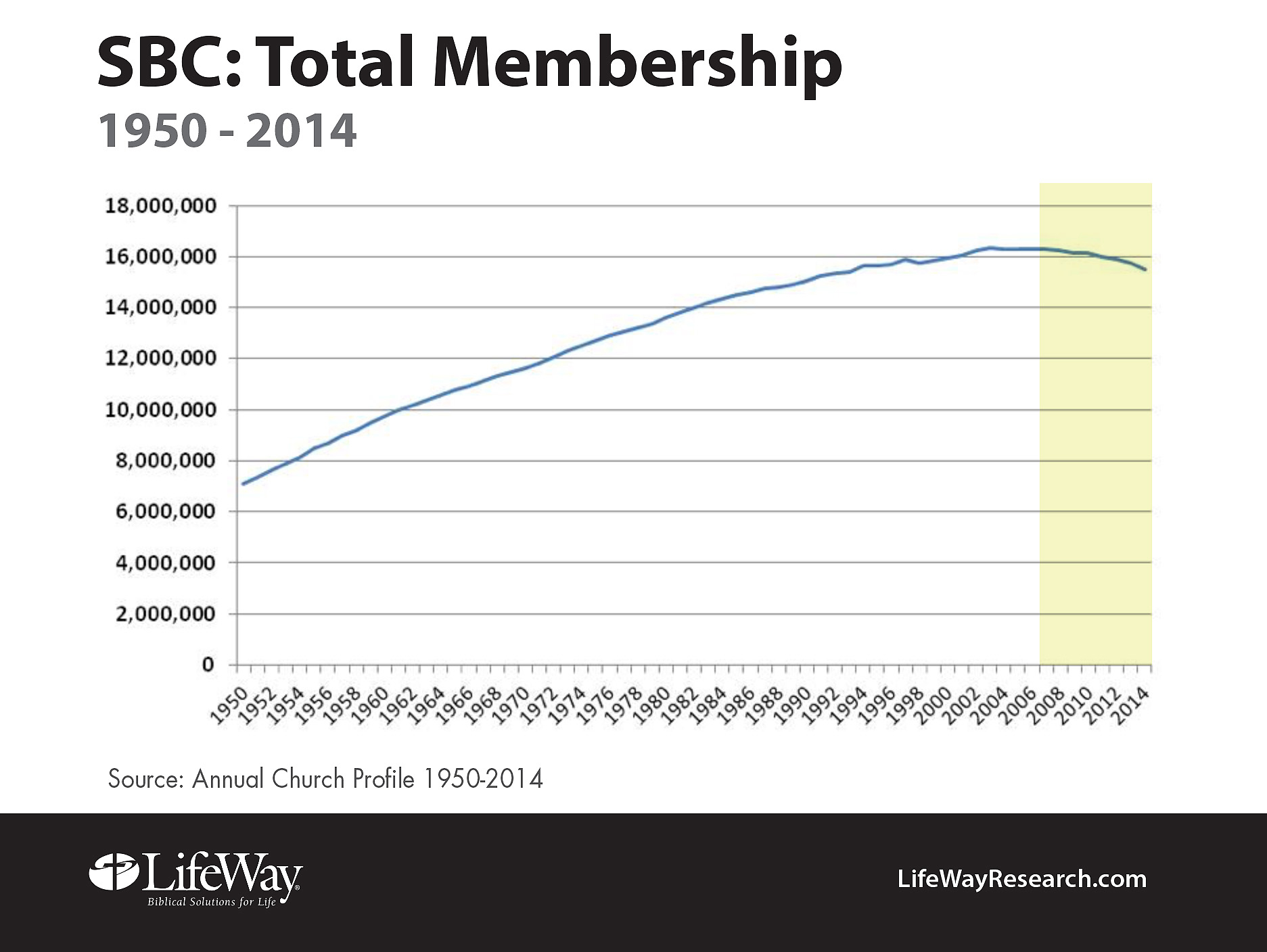
NASHVILLE (BP) — Southern Baptist leaders found a modicum of solace amidst national uncertainty for a number of years from a LifeWay Research chart illustrating Southern Baptist Convention membership since 1950.
In 2008, I wrote that Southern Baptists shouldn’t build their denominational confidence on this chart, because the growth of the Convention seen in the 1950s slowed as it approached the new millennium.
In 2009, Cliff Tharp, the late, well-known LifeWay statistician, noted: “We have been slowing in our growth and have now passed into decline. We are right at the top of the arc and beginning to go down. But changes we make now can change that trend significantly. These stats are not new, but it has never caught anyone’s attention until now.”
The just-released 2014 Annual Church Profile report shows the pattern continuing on track with the trend line first gaining national prominence in 2008. Membership, baptisms and weekly worship attendance continue to decline.
Don’t be shocked
 Sometimes I miss the days when people debated if we were about to head into decline. But this shouldn’t shock us. Like Cliff said: It’s just math. And, Cliff warned us, we needed to make changes.
Sometimes I miss the days when people debated if we were about to head into decline. But this shouldn’t shock us. Like Cliff said: It’s just math. And, Cliff warned us, we needed to make changes.
Yet, in 2008 there was a flurry of articles and debates about these numbers. National leaders spoke of this as a blip. It wasn’t then — I think everyone now agrees — and it isn’t now.
The Southern Baptist Convention is declining and, if the trend continues, the decline will accelerate.
Because, while some statistics show us that membership has increased since 1950, others show us we have increased at slower rates for decades, eventually dipping into decline, which is where we are today.
The chart of concern
 The chart that should concern Southern Baptists is one that shows growth versus decline from 1950 through last year. If this trend continues, decline will not merely continue, it indeed will accelerate. Follow that trend line and soon the SBC will be declining at 2 percent a year, then 3 percent, then…
The chart that should concern Southern Baptists is one that shows growth versus decline from 1950 through last year. If this trend continues, decline will not merely continue, it indeed will accelerate. Follow that trend line and soon the SBC will be declining at 2 percent a year, then 3 percent, then…
In 2013, the SBC claimed 15,735,640 members, and in 2014, that number fell by 236,467 to 15,499,173 — that’s a 1.5 percent decline. However, on this statistic alone, the claim could be made that churches are simply clearing out the cobwebs and tidying up their membership rolls, so their numbers more accurately reflect their active members.
The problem is, membership isn’t alone in its decline — it’s joined by baptisms and weekly worship attendance.
In 2013, Southern Baptist churches reported 310,368 baptisms. Last year, they reported 305,301, down by more than 5,000 baptisms, or 1.63 percent.
The highest percentage of decline last year was in weekly worship attendance. In 2013, 5,834,707 people attended SBC churches for worship each week. In 2014, that number dropped by 2.75 percent, or 160,238, to 5,674,469.
What now?
At the core, these numbers tell us this: It is as important as it has ever been for Southern Baptists to share and show the love of Jesus.
But that does not require a Southern Baptist Convention. That’s true for nondenominational churches as well.
So, for the future, the SBC needs to find a way to cooperatively work together — what SBC President Ronnie Floyd has called “visible unity” — to lead out in evangelism and church planting, provide resources for church revitalization, engage young and more non-Anglo leaders, and do so as a denominational family.
Facts are our friends, and the fact is the SBC decline is not reversing. It is not too late to make changes that will reverse the decline, but we must do so together.















